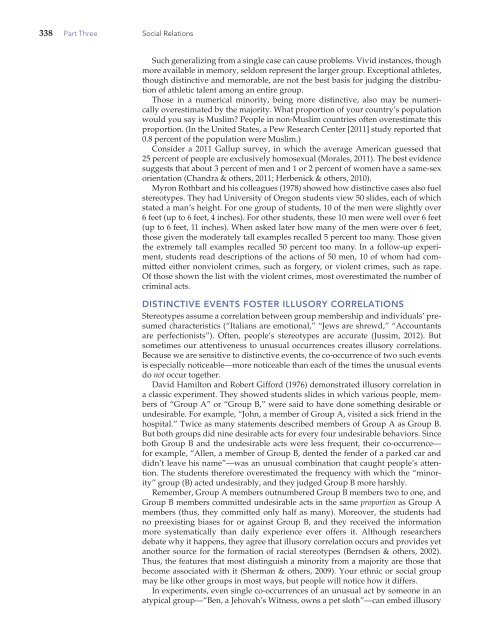Chapter 9: Prejudice: Disliking Others (2947.0K) - Bad Request
Chapter 9: Prejudice: Disliking Others (2947.0K) - Bad Request
Chapter 9: Prejudice: Disliking Others (2947.0K) - Bad Request
You also want an ePaper? Increase the reach of your titles
YUMPU automatically turns print PDFs into web optimized ePapers that Google loves.
338 Part Three Social Relations<br />
Such generalizing from a single case can cause problems. Vivid instances, though<br />
more available in memory, seldom represent the larger group. Exceptional athletes,<br />
though distinctive and memorable, are not the best basis for judging the distribution<br />
of athletic talent among an entire group.<br />
Those in a numerical minority, being more distinctive, also may be numerically<br />
overestimated by the majority. What proportion of your country’s population<br />
would you say is Muslim? People in non-Muslim countries often overestimate this<br />
proportion. (In the United States, a Pew Research Center [2011] study reported that<br />
0.8 percent of the population were Muslim.)<br />
Consider a 2011 Gallup survey, in which the average American guessed that<br />
25 percent of people are exclusively homosexual (Morales, 2011). The best evidence<br />
suggests that about 3 percent of men and 1 or 2 percent of women have a same-sex<br />
orientation (Chandra & others, 2011; Herbenick & others, 2010).<br />
Myron Rothbart and his colleagues (1978) showed how distinctive cases also fuel<br />
stereotypes. They had University of Oregon students view 50 slides, each of which<br />
stated a man’s height. For one group of students, 10 of the men were slightly over<br />
6 feet (up to 6 feet, 4 inches). For other students, these 10 men were well over 6 feet<br />
(up to 6 feet, 11 inches). When asked later how many of the men were over 6 feet,<br />
those given the moderately tall examples recalled 5 percent too many. Those given<br />
the extremely tall examples recalled 50 percent too many. In a follow-up experiment,<br />
students read descriptions of the actions of 50 men, 10 of whom had committed<br />
either nonviolent crimes, such as forgery, or violent crimes, such as rape.<br />
Of those shown the list with the violent crimes, most overestimated the number of<br />
criminal acts.<br />
DISTINCTIVE EVENTS FOSTER ILLUSORY CORRELATIONS<br />
Stereotypes assume a correlation between group membership and individuals’ presumed<br />
characteristics (“Italians are emotional,” “Jews are shrewd,” “Accountants<br />
are perfectionists”). Often, people’s stereotypes are accurate (Jussim, 2012). But<br />
sometimes our attentiveness to unusual occurrences creates illusory correlations.<br />
Because we are sensitive to distinctive events, the co-occurrence of two such events<br />
is especially noticeable—more noticeable than each of the times the unusual events<br />
do not occur together.<br />
David Hamilton and Robert Gifford (1976) demonstrated illusory correlation in<br />
a classic experiment. They showed students slides in which various people, members<br />
of “Group A” or “Group B,” were said to have done something desirable or<br />
undesirable. For example, “John, a member of Group A, visited a sick friend in the<br />
hospital.” Twice as many statements described members of Group A as Group B.<br />
But both groups did nine desirable acts for every four undesirable behaviors. Since<br />
both Group B and the undesirable acts were less frequent, their co-occurrence—<br />
for example, “Allen, a member of Group B, dented the fender of a parked car and<br />
didn’t leave his name”—was an unusual combination that caught people’s attention.<br />
The students therefore overestimated the frequency with which the “minority”<br />
group (B) acted undesirably, and they judged Group B more harshly.<br />
Remember, Group A members outnumbered Group B members two to one, and<br />
Group B members committed undesirable acts in the same proportion as Group A<br />
members (thus, they committed only half as many). Moreover, the students had<br />
no preexisting biases for or against Group B, and they received the information<br />
more systematically than daily experience ever offers it. Although researchers<br />
debate why it happens, they agree that illusory correlation occurs and provides yet<br />
another source for the formation of racial stereotypes (Berndsen & others, 2002).<br />
Thus, the features that most distinguish a minority from a majority are those that<br />
become associated with it (Sherman & others, 2009). Your ethnic or social group<br />
may be like other groups in most ways, but people will notice how it differs.<br />
In experiments, even single co-occurrences of an unusual act by someone in an<br />
atypical group—“Ben, a Jehovah’s Witness, owns a pet sloth”—can embed illusory

















